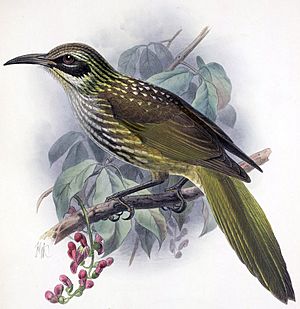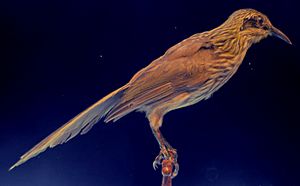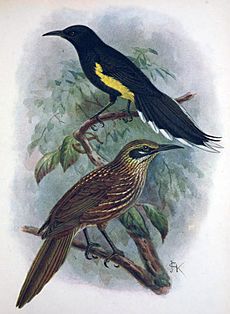Kioea facts for kids
Quick facts for kids Kioea |
|
|---|---|
 |
|
| Illustration by Keulemans | |
| Conservation status | |
| Scientific classification | |
| Genus: |
Chaetoptila
|
| Species: |
angustipluma
|
The kioea (Chaetoptila angustipluma) was a special Hawaiian bird. It became extinct around 1859. Even before Europeans found Hawaiʻi, the kioea was already becoming rare. Native Hawaiians didn't seem to know much about this bird. Its feathers were not used in Hawaiian featherwork, and it's not mentioned in their old songs or legends. Today, only four kioea specimens exist in museums. We don't know exactly why it died out.
What Did the Kioea Look Like?
The kioea was a large bird, about 33 centimeters (13 inches) long. It had a long, slightly curved bill. What made the kioea special was a wide black stripe on its face. It also had stiff, bristle-like feathers on its head and chest. The Hawaiian word "kioea" means "stand tall," which describes how the bird looked.
All four known kioea specimens were found on the island of Hawaiʻi. However, fossils show that similar birds lived on other Hawaiian islands too. For example, a bird called the Oahu kioea was found on Oahu and Maui. Another type, the Narrow-billed kioea, was also found on Maui.
How Scientists Group the Kioea
Scientists group living things into families based on how they are related. For a long time, the kioea and birds in the genus Moho were thought to be part of the Meliphagidae family. This family includes birds called honeyeaters. The kioea looked and acted very much like honeyeaters.
But in 2008, scientists did a new study. They looked at the DNA from museum specimens of these birds. This study showed that Moho and Chaetoptila (the kioea's genus) were not actually honeyeaters. Instead, they were more closely related to birds like waxwings and palmchats. They seemed especially close to silky-flycatchers. Because of this, the scientists suggested a new family just for these two extinct groups of birds. They called this new family Mohoidae.
See also
 In Spanish: Kioea para niños
In Spanish: Kioea para niños




